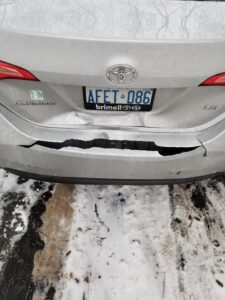This post is about an unpleasant experience in our family. I waited until the story was completed, so what I wrote would be reflective rather than emotional. Just before Christmas, our car was rear-ended and there was considerable property damage, but thankfully no injuries. Wondering whether it had been totaled was a real buzzkill over the holidays. What lessons can be learned from our experience?
Just the Facts
In the early evening just before Christmas, my wife and one of our children were approaching a major intersection not far from our home. The light at the intersection had turned red. There is a firehall on the corner, and a fire truck was racing out of the firehall into the street with lights flashing and sirens blaring. My wife stopped our car at the edge of the yellow box on the roadway indicating where the firetruck enters it. There were cars stopped on either side of ours, one in the left turn lane, the other in the curb lane. Thus, she was boxed in, with nowhere to go.
Then a large, expensive, late-model SUV plowed into the rear of our car. That neither my wife and child were hurt is due to their wearing seatbelts of course and also to the sturdy construction of our Corolla. It was immediately clear that the entire back bumper assembly, lights, and trunk cover were beyond repair. The driver of the other car wasn’t hurt, but their air bag deployed and there was so much damage to their car that it had to be towed.

Reporting the Collision
The accident was seen by fire personnel, and they advised both my wife and the other driver to go to a collision reporting centre because police would not go to a traffic accident in which there were no injuries, especially during evening rush hour.
My wife and I went to a nearby collision reporting centre and noticed the other driver and their spouse there. The process was quick and the electronic kiosk easy to use to file a report that included information about our vehicle, our insurance, and how the accident happened. Ontario’s collision reporting centres can be considered a public sector innovation because they streamline the process of accident reporting, eliminate calls to the police to attend to with minor accidents, and give drivers with moveable cars an incentive to stop disrupting the flow of traffic. On the other hand, police miss some accidents for which an investigation and charges would have been warranted.
The Other Driver’s Responsibility
At the scene of the accident, the other driver quickly accepted fault and was apologetic. Our immediate reaction was relief that there were no injuries. At the reporting centre, there was an awkward politeness (how Canadian!) between us and the other couple. By the next day, we were angry. The other driver didn’t respond to the red light, to the firetruck’s lights and sirens, or even to the sophisticated collision avoidance system that an upscale late-model car would undoubtedly be equipped with. What was the other driver thinking? Were they distracted or, worse, impaired? And why were they not paying attention?
Had the police investigated the accident, it is likely the other driver would have been charged with following too closely, careless driving, and failing to slow down for an emergency vehicle. The other driver is now dealing with the financial consequences of an expensive at-fault collision. But I don’t think I’m being vindicative to want the other driver to have been held accountable in a court of law. By being held accountable I mean precisely that: being forced to explain and justify their behaviour. Perhaps they would have an explanation or perhaps they would plead guilty. And perhaps the legal process would have made it more likely they would change their behaviour in the future.
The Aftermath
Repairing our car took 6 full weeks. Dealing with the insurance company and repair shop was delayed by the Christmas holidays. We were wondering anxiously if our car had been totaled, and we weren’t getting a quick answer. The repair shop estimated the repairs at $10,000 and over 70 hours of labour – a lot, but not so much that a relatively new car would be a write-off.
One of the key parts was on back order. The insurance company is obligated to provide only after-market parts and in a few cases we were willing to pay the difference to order OEM (original equipment manufacturer) parts. Both these factors added a few days’ delay. We did have a comparable rental car provided, but we prefer our own. We have our car back now and all waiting and hassle are over.
The key lesson from our experience is to drive defensively. But the uncomfortable realization is that driving defensively might not be enough.

Leave a Reply